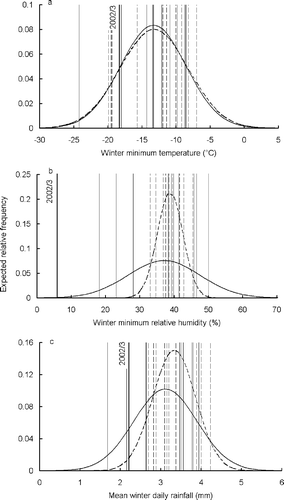Figures & data
Figure 1 The study area. Main map: central part of Abernethy Nature Reserve, showing Reserve boundary (black line), forest area (grey), study plots (forest plots, circles; forest edge plots, diamonds; heathland plots, triangles (closely clustered at the east side of the map); and Forest Lodge (cross, British National Grid NJ020161; 57°14.2′ N, 3°37.5′ W). Inset: part of Scotland, showing the Cairngorms National Park (black line), Abernethy Reserve (black), and Aviemore meteorological station (triangle; British National Grid NH897143; 57°12.3′ N, 3°49.6′ W).

Table 2. Correlates of the spatial pattern of Calluna die-back. Analyses were carried out in a generalised linear modelling framework, with percentage die-back as the dependent variable. The table shows parameter estimates for variables included in minimally-adequate models, selected using a step-wise procedure. Dashes indicate where a variable was not tested, as data were not available at that spatial scale. Standard errors and P-values are given in curved and square brackets respectively. Calluna percentage die-back (the dependent variable) was arcsine (fourth-root) transformed at the point scale, with means taken at higher spatial scales
Figure 2 Moisture contents (as percent fresh weight) of vegetation identified as live, in spring 2002 (triangles) and spring 2003 (circles). Each point represents one vegetation sample at one of the forest plots. (a) Calluna shoots (fine terminal stems and imbricate leaves); (b) Calluna fine stems (0–2 mm diameter); (c) Calluna medium stems (2–5 mm); (d) Calluna large stems (5–10 mm); (e) Vaccinium myrtillus stems; (f) Vaccinium vitis-idaea leaves; (g) Vaccinium vitis-idaea stems; (h) Pinus sylvestris needles. Vaccinium vitis-idaea moisture content was not recorded in 2002.
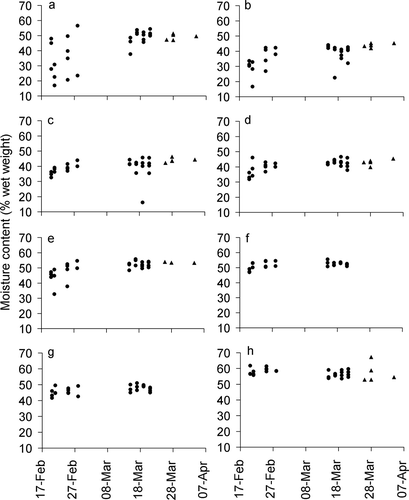
Table 1. Results of tests of hypotheses relating to the relationship between Calluna die-back and (a) shoot moisture content in spring 2003; (b) increase in Vaccinium myrtillus cover; and (c) microclimate in the following two winters. All results relate to the forest plots. All response variables were arcsine (fourth-root) transformed
Figure 3 Moisture content of green Calluna shoots in February 2003, plotted against subsequent Calluna die-back, as estimated in summer 2003. The data are from the forest plots, with each point representing one plot. At one plot (square symbol) the mean of two moisture readings is used, otherwise each plot is represented by one reading only. The back-transformed fitted relationships are also shown: solid line, moisture content represented by a continuous variable (); dotted line: moisture content represented by a two-level categorical variable. The curve in the solid line results from back-transformation of a linear relationship based on arcsine(fourth-root) transformed die-back scores.

Figure 4 Temporal changes in mean vegetation percentage cover following Calluna die-back: (a) live Calluna; (b) dead Calluna; (c) combined Vaccinium species; (d) combined graminoids. An arrow indicates the timing of the Calluna die-back event. Boxes show plot-scale medians and inter-quartile ranges, whiskers show 5th and 95th centiles. Means are shown by black circles. White bars: 2002; grey bars: 2003; bold stripe: 2004; fine stripe: 2005.
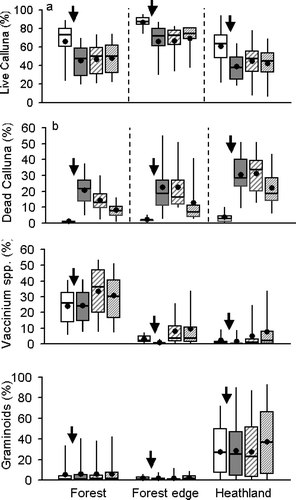
Figure 5 Annual, late-summer photographs illustrating the development of ground vegetation from one year before (2002), to three years after die-back (2005). The vegetation at two example cells, which had initially high Calluna cover, then high Calluna die-back, is shown. Each example consists of a column of four photographs, ordered by year, with 2002 as the upper photograph. Die-back occurred between the first (2002) and second (2003) photograph in each column. (four photographs forming the left-hand column of the figure) and (right-hand column) show a cell at a forest and heathland plot, respectively. Photographs are oblique views of cells, taken from a standing position 2 m from the cell centre, which is marked by a small yellow flag (visible in some of the photographs). Photographs were taken for illustrative rather than mensurative purposes, however an approximate (50 cm) scale for middle distances is given. The photographer's shadow has been digitally lightened in the 2005 photograph of .
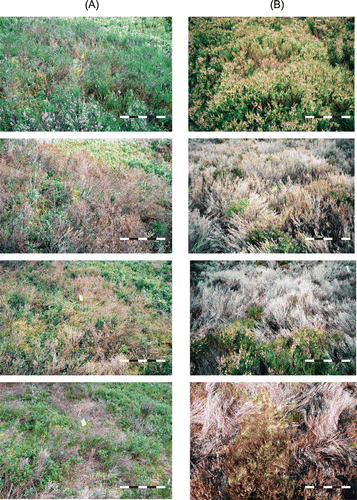
Table 3. Correlations between microclimate and topography at forest plots. Spearman correlations are given, for the finest spatial scale at which data were available, for each of the two measurement winters. Note that measurement of microclimate took place after die-back occurred, so there is potential for die-back to have affected these microclimate data
Figure 6 Daily weather readings during winter 2002–2003, when Calluna die-back occurred, and long-term means for the same day across the previous 15 winters. (a) Minimum daily temperature (°C). Black dots indicate winter 2002–2003 values. The greyed area shows the long-term mean daily minimum (central line), plus and minus two standard deviations (based on inter-annual variation for the same date), smoothed using a 30-day running average. Extended periods of ground frost (three or more consecutive days with grass temperature below 0 °C at 9 am GMT) are indicated with horizontal bars. (b) Minimum daily relative humidity (%). Key as . (c) Daily rainfall for winter 2002–2003 (bars) and long-term mean (line) (mm). Horizontal bars indicate periods of snow cover at Abernethy (Forest Lodge: ). All other readings are from the Aviemore weather station ().
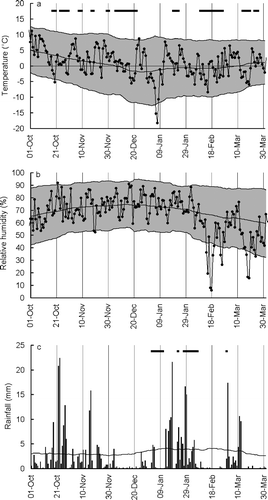
Figure 7 Winter (October–March) 2002–2003 weather readings in relation to longer-term data for Aviemore. Vertical lines show individual winters, while bell curves show fitted normal distributions. (a) All-winter minimum temperature; (b) all-winter minimum relative humidity; (c) mean winter daily rainfall. Normal distributions fitted to the longer-term pattern are shown for two 10-winter periods 1983–1984 to 1992–1993 (dotted) and 1993–1994 to 2003–2004, excluding 2002–2003, (solid). The y-axis shows expected relative frequencies. Individual winters (vertical lines), are dotted for 1983–1984 to 1992–1993, and solid for 1993–1994 to 2003–2004. The winter during which Calluna die-back occurred, 2002–2003, is shown in bold and individually labelled.
